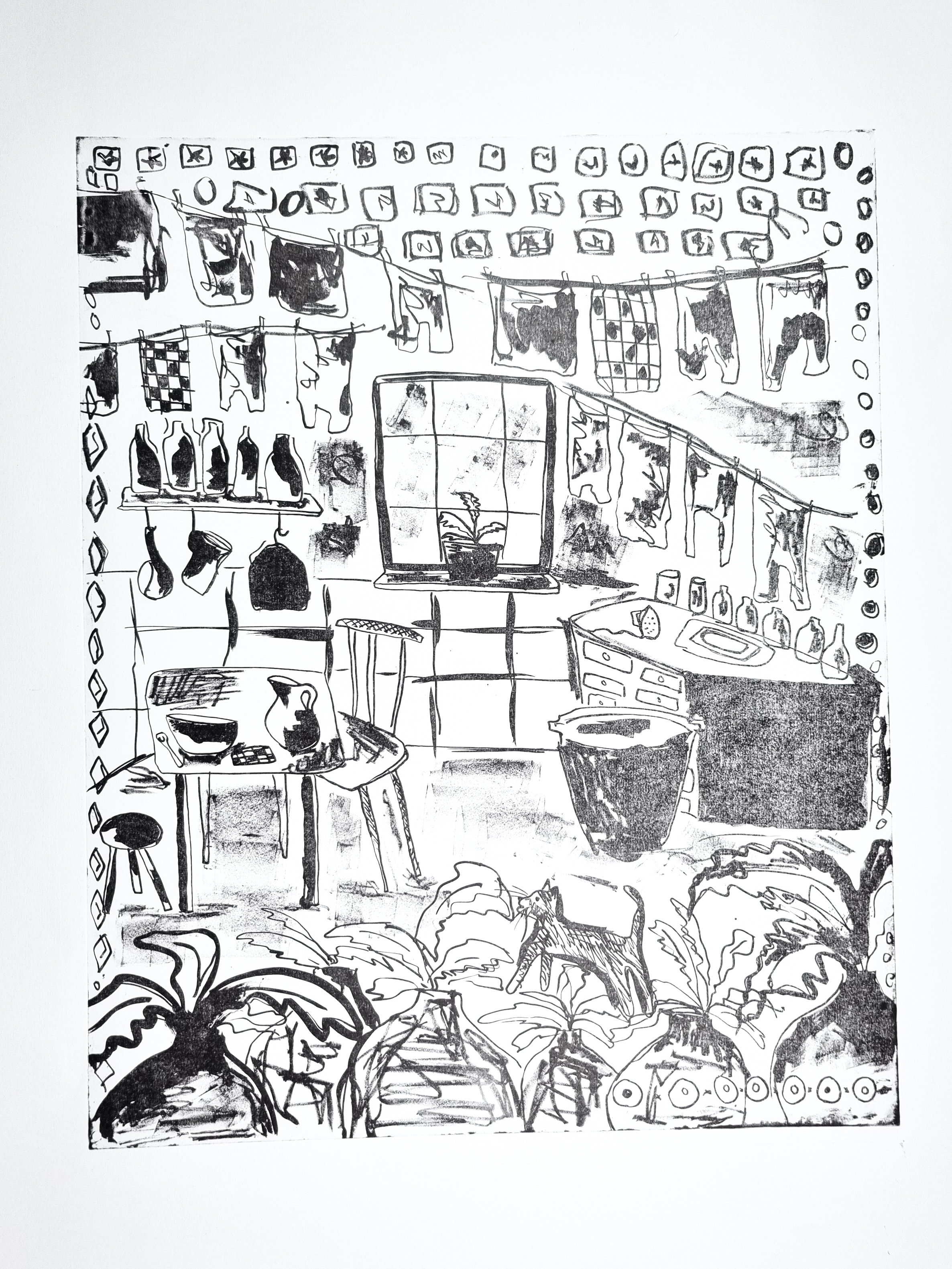Unit 1 Proposal and Practice
Artists Statement
My work is an exploration of modest domesticity. Quiet, often overlooked or trivialised moments that encourage collective reflection and enable the viewer to relate to a moment without having lived it. I have an enduring interest in personal anecdotes and memories.
Absence and presence is a continuing theme throughout my practice and I am intrigued by the spaces in between. The energy that objects can hold, their spirit and memory. I explore how grief, loss, memory and hauntings can surround us within domestic settings and our possessions that exist within them. Significantly those which have previously belonged to someone else, their ability to retell the stories of those who have passed whilst existing in domestic settings with those who are present. I combine printmaking, drawing, photographs, objects and writing to create a narrative where subtle questions can be made about the relationship between one and the other.
Unit 1 Proposal
Aims and objectives
I wish to strengthen the context of my practice and to integrate this more cohesively within my imagery to convey my ideas more clearly. I have always been interested in the female connotations that surround domesticity, however, I am eager to push my ideas further. I want to explore how memory, grief and loss can be intrinsically woven into our domestic lives and the objects that surround us. To question what we consider significant and insignificant in relation to everyday possessions and moments through anecdotal storytelling.
Methods
Over the duration of this course, I want to create a unified and thorough body of work surrounding my three key research areas:
Absence and presence within domestic settings
Anecdotes and memories provoked by commonplace objects
Objects given meaning through the exploration of the energy they contain
Process is important in my practice. I believe exploring these areas alongside the processes of printmaking is opening possibilities to expand my practice by creating more pathways in which I can express the meaning of my work and the context that I wish for it to exist in.
Key Artists and Thinkers
Cornelia Parker
Within her practice, Cornelia Parker transforms cultural artefacts and everyday objects, questioning what sculpture can be. Rather than using traditional sculptural techniques, she melds together ready-mades, reassembling them to give them new meanings. Her multi-disciplined practice is a commentary on current issues at the time of making. Therefore, her work, like the objects she uses, are markers of time and social and political situations.
Key elements:
Using objects which have a certain modesty or sentimental value
Objects almost becoming a time capsule as the mark a moment in time
A narrative that is created to the viewer by her choice of objects
Susan Hiller
Susan Hiller has described her work as ‘paraconceptual’ which could otherwise be characterised as where conceptual art and the paranormal meet. Her varied work is inspired by frequently overlooked aspects of our society including, dreams, postcards, automatic writing and near-death experiences. She gives a deep undertone to what can appear trivial and easily understood. Some of her works are those she has made previously and transformed into other works. For example, she has cut up previously exhibited paintings and turned them into sculptural books and has taken apart the threads of a painting on a canvas and used these threads to create line drawings.
Key elements:
Using frequently overlooked aspects of our society
Automatic writing and notions of the paranormal
Reconfiguring artworks into new forms
Tracey Emin
Tracey Emin’s practice is expressive and emotive. It draws on the fundamental themes of love, desire, loss and grief. Tracey Emin’s work is a personal and honest exploration of herself as a person and as a woman. Her paintings and drawings are gestural and at times ghostly in appearance. Her cursive text is suggestive and elusive. However, she also uses readymades and personal possessions that, similarly to her other works, are relatable and familiar, a story that as the viewer could be yours.
Key elements:
Using cursive text, reminiscent of automatic writing
Gestural and suggestive mark making
Relatable shared moments, familiar everyday
Gaston Bachelard
In his book, The Poetics of Space, philosopher Gaston Bachelard considers how through imagination and unconscious decision making, humanity can fill a domestic space and the objects that exist within it, with spirit and meaning. As a result, we are able to understand what it means to be living through the space that we inhabit. However, in turn, he believes that the home can evoke feelings and memories and that the objects and furniture within them can portray different personality traits. For example, as a consequence of their design and through the imagination of the owner, a chest of drawers could generate a sense of secrecy.
There is great focus on childhood memory and the emotional connections that we can have to the physical structure of a home. He attributes feelings of protection and intimacy to the interior of a home, particularly in contrast with the exterior and outside world that surrounds it. The perspective of this being, as a result of inhabiting a secure space and through small intimate moments, humanity is able to consider the immensity of the world.
Key elements:
Objects being given spirit and meaning
Personifying the home
Small moments being elevated












